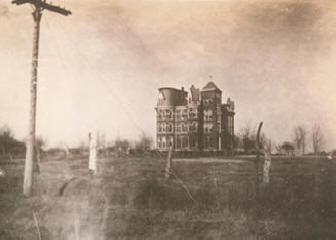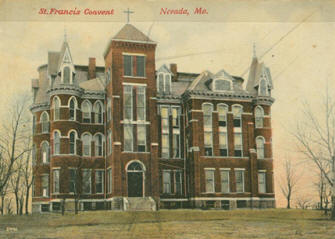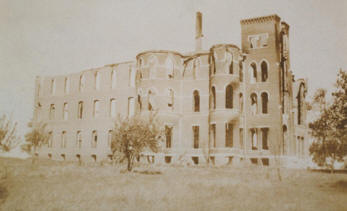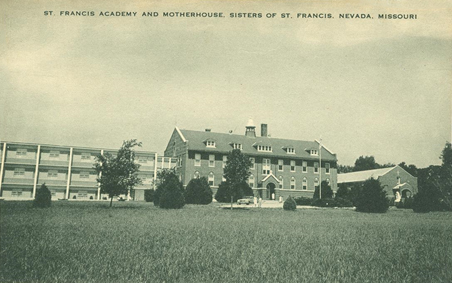ST. FRANCIS ORPHANS HOME
The St. Francis Orphans Home was in operation in Nevada, Missouri from 1896 until 1952. The facility then became St. Francis Academy, a boarding and high school for girls. In 1982 the Academy was relocated to Independence, Missouri where it continues operation.
There are not many records other than the names of children prior to the 1915 fire (see below). After 1915, there are usually some school records and sometimes other information about the children. The orphanage is enumerated in the U.S. Federal Census, and the children are listed.
You can contact the Sisters of St. Francis regarding possible records on an orphan. It is suggested that you send a written request to the following address and enclose a stamped self-addressed envelope and contribution to help cover copying charges for records that may be found. (If a large number of pages are copied and sent to you, please reimburse the Academy for the expense.)
Sisters of St. Francis
2100 North Nolan Road
Independence, MO 64050
It is recommended that your request be in writing because it is easier to go to the archives and look for information without being rushed on a phone call.
Below are picture postcards, the history of the orphans' home, and newspaper stories about the home and children from the local newspaper.
|
|
|
|
|
|
|
|
|
ST. FRANCIS ORPHANS’ HOME
St. Francis Orphan’s Home, where about one hundred children are given comforts of a home and receive every care and attention that an ideal mother could give, is conducted by the Sisters of St. Francis of Perpetual Adoration. On December 12, 1892, a band of five sisters, namely Sister M. John Hau as superior, Sister M. Bernandine Fah, Sister M. Bonaventure Rosenberg, Sister M. Xavier Blatter and Sister M. Basilia King, arrived at Conception, Mo., where they entered the Benedictine Convent to study the English language. They had been sent from Grimmerstein Convent, Walzenhauser, Appenzell county, Switzerland, with a mission to care for homeless children.
During the following year the building which they now occupy, together with twenty acres of land, was purchased by the sisters from Rt. Rev. Ignatius Conrad. The sisters arrived in Nevada September 3, 1893, and on September 15 opened a day school. In November, of the same year, Sisters M. Creszentia Gruniger, M. Angela Baumgartner and M. Ignatius Buhman arrived from Switzerland to take up their duties at the orphanage. The sisters experienced many hardships during the first few years of their residence here, but through the splendid business qualifications of Sister M. John, and the hearty co-operation and untiring energy of the sisters of her community, the institution made progress. The only source of revenue came from the tuition of their pupils, and the soil which they tilled.
The first orphans were received January 26, 1896, and then it was that the noble work to which they had dedicated their lives had its real commencement. St. Francis Orphans’ Home was incorporated under the laws of Missouri, at Jefferson City, October 16, 1900. After the incorporation papers were received the institution became what is termed a mother house with the privilege of admitting novices into their ranks. The election for the purpose of choosing one to guide the destinies of the institution and its inmates was held July 10, 1901, and Sister M. John was unanimously voted the Mother Superior, and each succeeding year she has been accorded the same honor. Mother John was born in Lentkirch, Wuttenburg, Germany, April 6, 1863, and entered the convent in April, 1881, becoming a sister during the month of October 1882. Her life has been one devoted to the welfare of humanity and the honor and glory of her Master. During her administration of St. Francis Orphans’ Home, fourteen novices have become brides of the cloister that they might assist in caring for the children of the poor. Since their residence here two sisters have been called to their eternal reward—Sister M. Basilia and Sister M. Elizabeth. Among the many children that have been received at the home not one death has occurred.
The sisters have purchased land from time to time, until now St. Francis Heights comprises about 200 acres. A few years ago it was seen that the original building was fast becoming inadequate to meet the demands made upon it owing to the number of children it was called upon to shelter and on March 17, 1910, a twenty-five room addition was started which is now nearing completion. Within the walls of St. Francis Home, sweet charity pure and unalloyed is practiced by the noble daughters of St. Francis and through their zeal one of Nevada’s most laudable institutions is conducted.
Johnson, J. B. (1911) History of Vernon County Missouri. p.476-477.
West Ashland Street, Home to Many
By Carolyn Gray Thornton
Today we are beginning a short series about the St. Francis Orphans’ Home, which was in the buildings which are now Heartland Hospital. A tribute to the institution written by Elmer J. Battraw who was a resident there from 1929 to 1936 was discovered in the Chamber of Commerce office and donated to the Bushwhacker Museum. In Bartraw’s 94-page narrative of his time there we found a history of the buildings called, “The Halls of Heartland Hospital,” written by Lorrie J. Mallard. We will start the series with a summary of her moving story. The background will help us appreciate the boy’s story more fully.
The original building on the location of the present Heartland Hospital was built in 1889 by the Christian Church for a university. That lasted only one year. In 1890 it was sold to the Benedictine Abbey of Subiaco, Ark., for a boys’ school. Then in 1892 the Franciscan nuns bought the building, without seeing it, for $10,000. Father Basil and Brother Stephen from the Arkansas Abbey cared for the property until the nuns arrived, after having spent 10 months learning English. The sisters arrived in Nevada on Sept. 3, 1893, and on the 15th of that month opened a day school.
In January of 1896 a widowed railroad worker named Hogan asked Mother John to give his four small children a home. That changed the service as more and more children were added. For more than 50 years the St. Francis Orphanage continued to care for children who needed a home. It was incorporated as St. Francis Orphans’ Home on Oct. 16, 1900. It also became a Mother House with the privilege of admitting novices into the convent. Twenty-six-year-old Sister M. John Hau was voted the Mother Superior and retained that responsibility until her death in 1948.
On the night of Sept. 25, 1915, a fire destroyed a new wing and the old college building. There are conflicting stories about how the fire started but the Sisters discounted them. Sister Gertrude heard the sound of the fire, awakened Sister Clara and then had Sister Frances get the girls out of the building while she ran back upstairs to rescue the boys. She had them line up two-by-two, an older boy with a younger one, and take their bundle of clothes that was at the foot of each bed ready for Sunday service, and walk hand-in-hand down four flights of stairs. Every child and staff person was saved.
The closest city fireplug was five blocks away and they relied on the Missouri Pacific pumping plant on the Marmaton River for fire protection.
That night, before the pressure on the pumps could be raised the building was gone. The streams of water could not be thrown more than six feet.
The community responded to the needs of the Sisters and the children by donating supplies, space, clothing, money and physical help. The Mitchell Hotel fed the 68 children for breakfast and supper on Sunday and at noon the children went to private homes.
A house owned by Dr. J. F. Robinson that had been built as a dormitory for the proposed university was donated and by Monday night the children were housed there and cooking and dining facilities were ready.
In 1940 the Sisters were encouraged to accept more girls to encourage vocations in the sisterhood, and at the end of the winter term in 1952 the grade school discontinued and the institution became St. Francis Academy, a boarding and high school for girls. 61 were enrolled for the 1967-’68 year.
In 1982 the nuns relocated on Noland Road in Independence and Heartland Hospital opened its doors in October of that year, still serving the needs of children.
The Nevada Daily Mail, Nevada, Vernon County, Missouri. July 15, 2005
MY TRUE HOME FOREVER
By Carolyn Gray Thornton
In 1929 Elmer J. Battraw and his brother Bill were brought to Nevada to live at the St. Francis Convent and Orphanage. In 1992 in honor of the centennial of the Sisters of St. Francis of the Holy Eucharist being in the United States, Elmer Battraw wrote a 92-page historical perspective and autobiography of a little boy’s life, 7- to 14-years-old at the St. Francis Orphanage. The title of his manuscript is “My True Home Forever.”
The title gives a very strong hint of the respect and love that Elmer had for the institution and the care he received while there. His brother left the orphanage two years before Elmer did, but upon reading his brother’s story added comments of his own.
The narrative, with the brother’s remarks is now preserved in the Bushwhacker Museum after having been found in the Nevada Chamber of Commerce office in a box of papers.
We attempted to find out if either Elmer or Bill were still alive so that we might interview them to tell “the rest of the story.” However we were saddened to find Elmer’s obituary on the Internet. It did not list any siblings among his survivors. However it did inform us that he married, had three children, 11 grandchildren and one great-grandchild at the time of his death on April 1, 2004. He had been a radio operator supervisor for the U.S. Border Patrol for 40 years before retiring in 1984. His adult life was lived in Imperial, Calif.
His moving, amusing and informative narrative begins with a quotation by Feodar Dostoyevsky: “There is nothing higher and stronger and more wholesome and useful for life in later years than some good memories, especially a memory connected with childhood, with home. If a man carries many such memories with him into life, he is safe to the end of his days, and if we have only one good memory left in our hearts, even that may sometime be the means of saving us.”
Elmer follows this quotation with his remark: “If this be true of only one memory, what can be said of thousands upon thousands of wonderful happy ones? For those who would like, you are invited to borrow from mine as told in these writings to attain that good end.”
He began his narrative on Monday, Feb. 8, 1993, saying that at long last he will make a beginning on his memories of St. Francis at Nevada. He thought it was fitting that that day was the feast of St. Jerome Emiliani, the patrol of orphans. He explains that he was not literally an orphan as his mother was alive, but his home life was such that he said he did not have homesickness or feeling of loss when he came to St. Francis.
His obituary mentions that after the war when he was a radio operator, he joined a monastery in Ponca City, Okla., but only stayed there about a year before leaving to care for his mother and stepfather. This would indicate that his relationship with his family remained important even though he spent these years at St. Francis.
In the next segment of this series we will tell more about the daily life of the children who lived there. But for now we want to emphasize that throughout the whole narrative tow things are very evident. First he was very happy at St. Francis and loved being there. Second, he became immersed in Catholic doctrine and practices and his faith was a strong influence on him even as a young boy.
Next week we will become better acquainted with Elmer.
The Nevada Daily Mail, Nevada, Vernon County, Missouri. July 22, 2005
Elmer J. Battraw, St. Francis Orphanage Resident from 1929-1936
By Carolyn Gray Thornton
Elmer Battraw came to the St. Francis Orphanage when he was 7-years-old and left after he graduated from the eighth grade when he was 14. These years left him with happy memories and a good solid education. In appreciation for the loving care he received at St. Francis, he wrote “a historical perspective and autobiography of a little boy’s life” titled “My True Home Forever.” We covered some of the contents in a previous article. Today we will cover more of Elmer’s personal story.
It is obvious that Elmer was greatly influenced by the religious atmosphere of the home and tells in detail the activities around different holy days and holidays. He became an altar boy at the age of 7 and was one chosen to go with the priest on monthly visits to the State Hospital and to a Catholic Church at Schell City.
The children at the home were required to be silent in their dormitories, at mealtime, and when moving from one activity to another in their lines of two by two. But they devised methods of communicating that did not require speech. He and his best friend, Alphonsus Bain, contrived a way to say the Rosary each night after going to bed. They decided before going to bed who would take the lead and who would follow. They tied one end of a long string to the big toe of one of them, ran the string along the beds that separated the two boys and tied the other end to the toe of the second boy. The leader would begin saying the Rosary to himself and would pull on the string to signal to his friend that it was time for his response. Then when that was finished the second boy pulled on the string again for the leader to resume.
Elmer said they worked this system for several nights before they gave up because one or the other would fall asleep before they were finished.
Elmer spoke fondly of the games they played with very little equipment or supplies. The boys and girls were separated in their playgrounds and in most of their activities so his record tells little about the girls’ days.
However the boys had their time spaced with religious observances, school, work and play. They had various placed they could play in addition to the playground. They would be taken to the woods, to an area called Fairyland, and to a pasture. They went barefooted throughout the summer except for Sunday, and Elmer tells of their joy in stepping in cow piles in the pasture to feel the manure squeeze between their toes. He also said that a daily nighttime routine was for each child to wash his feet before going to bed! In the summer, usually on Saturday mornings, they would walk to Radio Springs Park to go swimming, but sometimes they also swam in a nearby creek in a spot that was deeper. He tells of drinking from a spring and the creek when on outings such as berry picking or gathering nuts.
The sisters were on a very tight budget so their food was simple. He mentions sweet potatoes often and some soup made with tapioca. (He said he could never eat anything with tapioca in it the rest of his life.) The life was healthy as he said he had very few illnesses in his seven years there. One was severe poison ivy doubled with mumps, another was pneumonia. He didn’t recall any of his friends being sick often either.
When he was 14 he received a call that his mother and stepfather had sent him a bus ticket to California, so he hurriedly gathered some possessions and left with mixed feelings because he loved being at St. Francis.
Although he went to California his obituary says that he graduated from Joplin High School so he must have returned to Missouri. He served in World War II and became a radio operator supervisor for the U.S. Border Patrol in California, where he died, April 1, 2004.
The Nevada Daily Mail, Nevada, Vernon County, Missouri. July 29, 2005
Please email your family member's reminiscences and pictures about life at the St. Francis Orphans' Home to be shared here.







